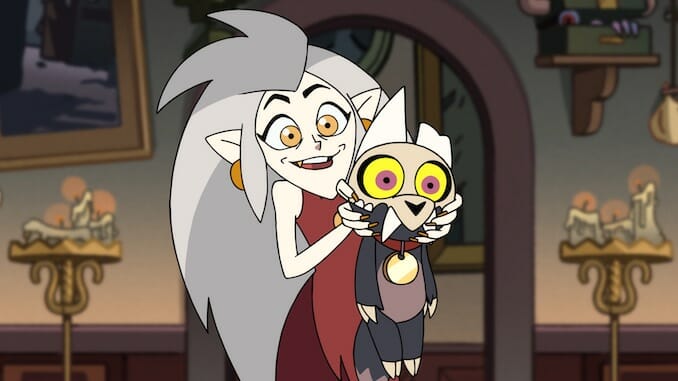Could The Owl House Have Thrived as a Disney+ Original?
Photo Courtesy of The Disney Channel
Disney Channel’s The Owl House was originally planned for a three season story arc, but it’s being cut short. Rather than a full Season 3, it will conclude with three hour-long specials. With fan campaigns asking Disney to make more of The Owl House becoming major Twitter trends, series creator Dana Terrace took to Reddit to explain why the show was canceled.
In the post, Terrace shot down most of the speculated reasons for The Owl House’s cancellation: it wasn’t due to ratings (which she says were good by Disney Channel’s standards); it probably wasn’t due to backlash against the show’s LGBTQ+ representation; it couldn’t be explained by pandemic-era budget restrictions alone. It seems the issue was the opinion of a single executive. “At the end of the day,” Terrace wrote, “there are a few business people who oversee what fits into the Disney brand and one day one of those guys decided TOH didn’t fit that ‘brand.’ The story is serialized (BARELY compared to any average anime lmao), our audience skews older, and that just didn’t fit this one guy’s tastes. That’s it!”
Serialized programming that skews towards a slightly more mature audience, however, is a huge part of the Disney brand, and the backbone of the original programming on Disney+. The Owl House’s serialization wouldn’t be the least bit out of place next to Star Wars: The Bad Batch or Monsters at Work, and it’s nowhere near as mature as the TV-14 What If…? The big difference between The Owl House and Disney+’s animated series so far is that The Owl House is completely original as opposed to a spinoff of a pre-existing IP, yet with the African sci-fi series Iwájú and the Pixar sports comedy Win or Lose in the works, Disney+ clearly isn’t opposed to new stories.
It makes no sense, then, to deem The Owl House a bad fit for the generalized “Disney brand”—it just might be a poor fit for the specific Disney Channel brand. At the Lightbox Expo for animation industry professionals, Disney development executives stated that Disney Channel’s brand is episodic comedy for 6-11 year olds, whereas Disney+ is for “family co-viewing.” In that light, The Owl House feels like a Disney+ show that had bad luck of being pitched a year or two too early and got stuck on the more restrictive cable network.
For what it’s worth, The Owl House seems to be doing well on Disney+, often showing up in the streaming service’s “Trending” selection. Streaming numbers, however, never had a chance of saving the show from cancellation—the decision was made before the first season had even finished airing on Disney Channel and well before the series was added to Disney+.
-

-

-

-

-

-

-

-

-

-

-

-

-

-

-

-

-

-

-

-

-

-

-

-

-

-

-

-

-

-

-

-

-

-

-

-

-

-

-

-








































